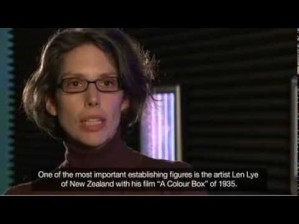
… cannot say much more at the moment, as that I definitely want to see this exhibition at the Schirn in Frankfurt!
“Celloluid. Cameraless Film” at the Schirn, Frankfurt a.M., Germany
The exhibition “Celluloid. Cameraless Film” the Schirn, Frankfurt, focuses on a particular art film genre …
| .. in which footage is produced by creating images directly on film stock. As opposed to other forms of experimental film, the material is removed from its conventional context of use and, as it were, interpreted as a canvas by applying diverse artistic processes: painting, drawing, collage on celluloid, scrapes and scratches in the emulsion, defamiliarization through chemical manipulations, or the direct exposure of the photosensitive material. The exhibition presents outstanding examples of cameraless film and offers a panorama from the 1930s to the present day with works by 21 international artists and film makers such as Stan Brakhage, Tony Conrad, Cécile Fontaine, Hy Hirsch, Len Lye, Norman McLaren, Luis Recoder, Harry Smith, José Antonio Sistiaga, and Jennifer West.
Applying paint to celluloid for coloring black-and-white films had been a current arts-and-crafts technique since the first days of cinematography. Yet it was only with the emergence of the film avant-garde that experiments with color and blank film stock became relevant as a generative principle of film production. The earliest hand-colored films were created by the Italian Futurists Arnaldo and Bruno Ginanni-Corradini between 1910 and 1912. Unfortunately, only detailed descriptions have survived from their nine direct animations painted on transparent celluloid. In the early 1920s, the Surrealist photographer Man Ray was the first to use the rayogram technique in film for some sequences of his “Le Retour à la Raison” (1923). |
|
| Len Lye (1901–1980) and Norman McLaren (1914–1987), who, pursuing different approaches, began to explore the possibilities of producing films without a camera more systematically in the mid-1930s. |
“Particles in Space” by Len Lye, 1979 |
| Len Lye’s film “A Colour Box” (1935), which the artist painted directly on the filmstrip, is considered to be the work which established the genre of cameraless film.
Synchronized to a popular Latin American tune, the film with its bright powerful colors, unusual textures, and the characteristic vibrations and pulsations of its projected images stood out against all hitherto known results in the field of art film. The tradition of direct animation was particularly taken up in the US postwar avant-garde film. Artist, film maker, folk music collector and occultist Harry Smith (1923–1991) discovered the hand-colored film as a possibility to combine his mystically inspired painting with his interest in music in the late 1940s. He produced a number of abstract films of impressive complexity by painting and using intricate stamping techniques – films whose rhythmically pulsating forms and colors create multi-sensory, proto-psychedelic pictorial worlds. Stan Brakhage (1933–2003) is to be considered as one of the key figures of experimental film in general. His film “Mothlight” of 1963, a radically personal meditation on life and death, already relied on the direct, cameraless approach for its powerful effect. The dancing flickering composition of moth wings, grasses, blossoms, and leaves ranks among the few classics of experimental film today and is to be regarded as a key work in the history of direct animation. Since the 1960s, numerous artists and avant-garde film makers have devoted themselves to direct film experiments. The gamut of works ranges from the Basque painter José Antonio Sistiaga’s (*1932) vibrating and permanently changing color worlds comprised of thousands of minutely executed individual drawings to Dieter Roth’s (1930–1998) sequences of letters scratched into black film. After a conspicuous boom of direct animation in the 1980s’ experimental film production, the cameraless approach seems to see a revival on a new level within the context of contemporary art. Jennifer West (date of birth unknown), for example, has produced a body of 50 direct films since 2004. She subjects her material to complicated interventions and procedures in a performative mise-en-scène. She uses all everyday materials conceivable, from food and lipstick to motorcycle tires, to work on different formats of film, which are also bathed in more or less effective substances, the respective concept revealing itself only through the title, such as in the case of her work “Film Wearing Thick Heavy Black Liquid Eyeliner That Gets Smeary (70 MM film leader lined with liquid black eyeliner, doused with Jello Vodka shots and rubbed with body glitter).” West’s immersive psychedelic filmic spaces powerfully recall the vision of film as synaesthetic art that pervades the history of direct film from Len Lye to Harry Smith and Stan Brakhage. |
|

One thought on “CELLOLUID. CAMERALESS FILM”
Comments are closed.